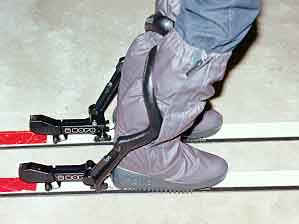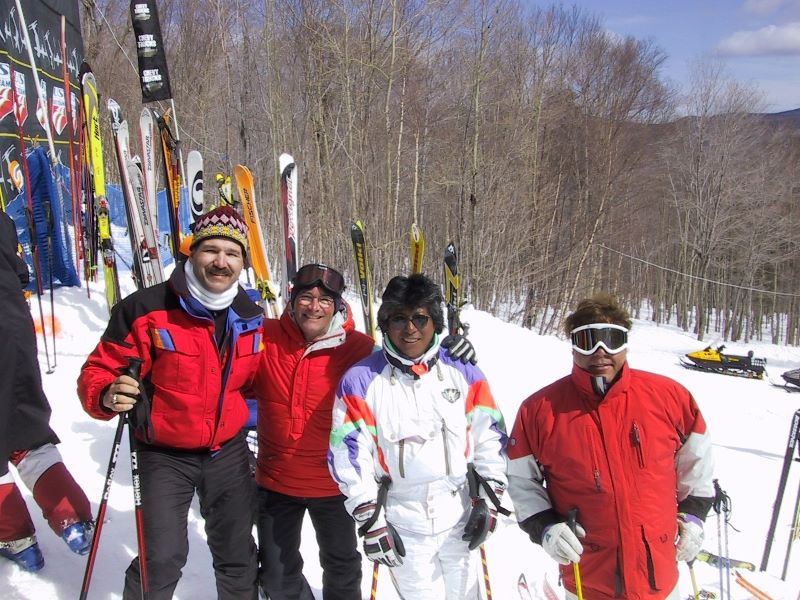|
Ski Boot
Ski boots are footwear used in skiing to provide a way to attach the skier to skis using ski bindings. The ski/boot/binding combination is used to effectively transmit control inputs from the skier's legs to the snow. History Ski boots were leather winter boots, held to the ski with leather straps. As skiing became more specialized, so too did ski boots, leading to the splitting of designs between those for alpine skiing and cross-country skiing (sport), cross-country skiing. Modern skiing developed as an all-round sport with uphill, downhill and cross-country portions. The introduction of the cable binding started a parallel evolution of binding and boot. The binding looped a strap around the back of the boot to hold it forward into a metal cup at the toe. Boots with the sole extended rearward to produce a flange for the cable to firmly latch to become common, as did designs with semi-circular indentations on the heel for the same purpose. Effective cross-country skiing requires ... [...More Info...] [...Related Items...] OR: [Wikipedia] [Google] [Baidu] |
Rosemount Ski Boots
Rosemount Ski Boots introduced one of the earliest all-plastic ski boots for the downhill skiing market, competing with Bob Lange for the title of "first". Rosemount's design was easily distinguished by its use of the uncommon "side-entry" method for putting the boot on, which was rare at the time and is no longer used. The boot was introduced by Rosemount Engineering, better known for their aerospace instrumentation. They referred to the boot division as either the Rosemount Consumer Products Division or Sports Technology. Rosemount sold the factory to Bass Sports in 1968, but the boots retained the Rosemount name throughout their production. Many variations of the design were introduced over the next four years, and Bass added ski bindings and ski poles as well. The rest of Rosemount became Rosemount Inc. when they were purchased by Emerson in 1976. Bass Sports was in turn purchased by Raichle in 1972, who ended production of the Rosemount boot in favor of their own design ... [...More Info...] [...Related Items...] OR: [Wikipedia] [Google] [Baidu] |
Footwear
Footwear refers to garments worn on the feet, which typically serves the purpose of protection against adversities of the environment such as wear from ground textures and temperature. Footwear in the manner of shoes therefore primarily serves the purpose to ease locomotion and prevent injuries. Footwear can also be used for fashion and adornment as well as to indicate the status or rank of the person within a social structure. Socks and other hosiery are typically worn additionally between the feet and other footwear for further comfort and relief. Cultures have different customs regarding footwear. These include not using any in some situations, usually bearing a symbolic meaning. This can however also be imposed on specific individuals to place them at a practical disadvantage against shod people, if they are excluded from having footwear available or are prohibited from using any. This usually takes place in situations of captivity, such as imprisonment or slavery, where ... [...More Info...] [...Related Items...] OR: [Wikipedia] [Google] [Baidu] |
Slipper
Slippers are light footwear that are easy to put on and off and are intended to be worn indoors, particularly at home. They provide comfort and protection for the feet when walking indoors. History The recorded history of slippers can be traced back to the 12th century. In the West, the record can only be traced to 1478. Slippers in China date from 4700 BCE. They were made of cotton or woven rush, had leather linings, and featured symbols of power, such as dragons. Native American moccasins were also highly decorative. Such moccasins depicted nature scenes and were embellished with beadwork and fringing, their soft sure-footedness made them suitable for indoors appropriation. Inuit and Aleut people made shoes from smoked hare-hide to protect their feet against the frozen ground inside their homes. Fashionable Orientalism saw the introduction into the West of designs like the baboosh. Victorian people needed such shoes to keep the dust and gravel outside their homes. For ... [...More Info...] [...Related Items...] OR: [Wikipedia] [Google] [Baidu] |
Ski Binding
A ski binding is a device that connects a ski boot to the ski. Before the 1933 invention of ski lifts, skiers went uphill and down and cross-country on the same gear. As ski lifts became more prevalent, skis—and their bindings—became increasingly specialized, differentiated between alpine (downhill) and Nordic ( cross-country, Telemark, and ski jumping) styles of skiing. Until the point of divergence in the mid-20th century, bindings held the toe of a flexible, leather boot against the ski and allowed the heel to rise off the ski, typically with a form of strap or cable around the heel. To address injuries resulting from falls while skiing downhill on such equipment, ski bindings emerged with the ability to release the toe of the boot sideways, in early models, and to release the boot forward and aft, in later models. Downhill ski bindings became standardized to fit plastic ski boots and incorporated a built-in brake that drags in the snow after the ski detaches from the boot. ... [...More Info...] [...Related Items...] OR: [Wikipedia] [Google] [Baidu] |
Snowboard
Snowboards are boards where the user places both feet, usually secured, to the same board. The board itself is wider than most skis, with the ability to glide on snow."snowboarding." Dictionary.com Unabridged (v 1.1). Random House, Inc. 17 Mar. 2009. . Snowboards widths are between 6 and 12 inches or 15 to 30 centimeters. Snowboards are differentiated from monoskis by the stance of the user. In monoskiing, the user stands with feet inline with direction of travel (facing tip of monoski/downhill) (parallel to long axis of board), whereas in snowboarding, users stand with feet transverse (more or less) to the longitude of the board. Users of such equipment may be referred to as ''snowboarder''s. ''Commercial snowboards'' generally require extra equipment such as bindings and special boots which help secure both feet of a snowboarder, who generally ride in an upright position. These types of boards are commonly used by people at ski hills, mountains, backcountry, or resorts for ... [...More Info...] [...Related Items...] OR: [Wikipedia] [Google] [Baidu] |
Nava System
The Nava System was a ski binding and custom ski boot offered for sale in the 1980s. The system used a combination of flexible sole plate to keep the boot centered, and a spring-loaded plastic arm on the rear binding that was used to transmit sideways motions of the leg to the ski. This eliminated the need for a hard shell on the boot; the Nava boot was soft and resembled a knee-high winter boot. In spite of numerous endorsements by racing stars, the system never caught on and sales ended by the late 1980s. History The system was invented in the early 1970s by an Italian architect and skier, Antonio Faullin. He patented the design and sold the production rights in the mid-1970s. No production commenced, and the design was subsequently sold off to a number of manufacturers.Swett The design eventually found its way to Pier Luigi Nava, an avid skier whose company produced motorcycle helmets. Using injection moulding Injection moulding (U.S. spelling: injection molding) is a man ... [...More Info...] [...Related Items...] OR: [Wikipedia] [Google] [Baidu] |
Cabriolet (carriage)
A cabriolet is a light horse-drawn vehicle, with two wheels and a single horse. The carriage has a folding hood that can cover its two occupants, one of whom is the driver. It has a large rigid apron, upward-curving shafts, and usually a rear platform between the C springs for a groom. The design was developed in France in the eighteenth century and quickly replaced the heavier hackney carriage as the vehicle for hire of choice in Paris and London. The ''cab'' of taxi- cab or "hansom cab" is a shortening of ''cabriolet''. Other horse-drawn cabs include: *''Araba'' or ''aroba'': used in Turkey and neighboring countries *''Araña'': Mexican, two-wheeled *''Bounder'': four-wheeled *'' Gharry'' or ''gharri'': used especially in India *'' Kalesa'' or ''calesa'' (sometimes called a ''karitela''): used in the Philippines *'' Dorożka in eastern Europe *''Minibus'': light carriage, usually with a rear door and seats for four passengers; formerly used as a cab *''Two-wheeler'': two- ... [...More Info...] [...Related Items...] OR: [Wikipedia] [Google] [Baidu] |
Freestyle Skiing
Freestyle skiing is a skiing discipline comprising aerials, moguls, cross, half-pipe, slopestyle and big air as part of the Winter Olympics. It can consist of a skier performing aerial flips and spins and can include skiers sliding rails and boxes on their skis. Known as "hot-dogging" in the early 1970s, it is also commonly referred to as freeskiing, jibbing, as well as many other names, around the world. History Ski acrobatics have been practiced since the 1930s. Aerial skiing was popularized in the 1950s by Olympic gold medalist Stein Eriksen. Early US competitions were held in the mid-1960s. In 1969, Waterville Valley Ski Area in New Hampshire, formed the first freestyle instruction program, making the resort the birthplace of freestyle skiing. The following year, Corcoran and Doug Pfeiffer, organized the first National Open Championships of Freestyle Skiing on the Sunnyside trails. In 1971, Waterville Valley Hosted the first Professional Freestyle Skiing Competitio ... [...More Info...] [...Related Items...] OR: [Wikipedia] [Google] [Baidu] |




